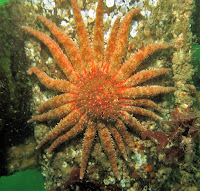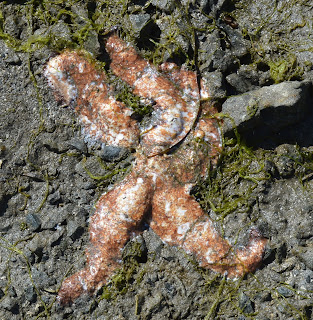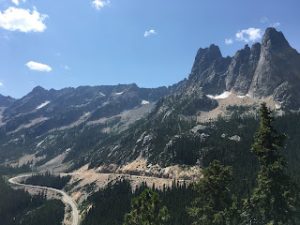Pictures of disintegrating sea stars from the west coast have made national news over the past few years. UW Biograd Mo Turner (Ruesink Lab) was on one of the teams studying the phenomenon working out of Friday Harbor during the summer of 2014. The work she did with her team that summer has just appeared in Philosophical Transactions of the Royal Society B (link). Way to go, Mo!
| Sick P. ochraceus. When diseased, stars often lose the ability to attach to surfaces with their tube feet. (Photo: M. Turner) |
The summer of 2014 was simultaneously one of the most interesting, fast-paced, yet most tragic research projects that I’ve had the pleasure to experience. Simply put, I studied the ecology of a disease, and fell in love with the host.
The outbreak of Sea Star Wasting Disease (SSWD) was first reported in early 2013, with high sea star mortality occurring both intertidally and subtidally across the coasts of California, Oregon and Washington. In a somewhat baffling manner, the disease spread rapidly along the west coast, spanning a wide range of temperatures and affecting more than 20 species of sea stars and killing the host within a relatively short period of time.
In 2014, the San Juan Islands in Washington, home to UW’s Friday Harbor Laboratories (FHL), provided a rare opportunity: the ability to study a population before it was affected by the disease. Early surveys and lack of wasting reports indicated that SSWD had not yet reached the islands. Dr. Drew Harvell, a disease ecologist from Cornell University, recognized this as a chance to “set up shop” in early 2014, predicting that the rising summer temperatures would likely promote a disease outbreak.
I joined the Harvell Team in the spring of 2014 and all hands were immediately on deck. It was a race against time as we anticipated the onset of SSWD. The mixed semidiurnal tide cycle of the Puget Sound allowed us to carry out intertidal surveys at lower-low tides every other week. During the other weeks, when the tides weren’t reaching maximum low and high tide heights, the water currents were moderate enough to allow for a series of subtidal surveys. In the remaining available time, we squeezed in a laboratory experiment to tease apart the relationship between the disease and water temperature.
While the intertidal zone was dominated almost entirely by Pisaster ochraceus, the purple or ochre star, the subtidal community consisted of more than ten species at lower densities. Although the disease appears to manifest a little differently in each species, they all share key symptoms: unusual contortion of the arms, lesions in the dermis (~skin) leading to breakdown of the body tissues, loss of limbs, and eventually death. In P. ochraceus the limbs often twisted, followed by the appearance of lesions on the body and the loss of one or two arms. The breakdown of the dermis gave the ochre stars an appearance of “melting”, progressing until all that was left was a puddle of ossicles (calcium plates embedded in the skin).
Perhaps the most dramatic symptoms were those of Pycnopodia helianthoides, the sunflower star. Although this large, 24-armed predator experienced similar contorted arms, twisted in tight circles, they often lost many arms over the course of a few days. Both in tanks and in the field, the arms of the individual appear to pull off and continue to travel away from the body, all independent of one another.
The gruesome nature of the disease lends itself well to zombie apocalypse metaphors for sea stars and nightmares of losing limbs for the scientists studying them. By the end of the summer, we had lost more than 90% of our sea stars in both the intertidal and subtidal zones. As the team packed up to head back to Cornell, I was left with many more questions and a longing to continue to research, sparking the decision to apply to the Ph.D. program here in Biology. How long do sea stars live even for? How do you tag an organism that is willing to drop its own limbs? Why do P. ochraceus cuddle in groups (observed in the wild and in tanks)?
What can we expect to see with the loss of the rocky intertidal keystone predator (shout out to Paine 1969)? More recent surveys of our sites suggest that P. ochraceus have some ability to rebound from the rapid, mass mortality however P. helianthoides (my personal favorite) are still very rarely observed in the wild. Keep an eye out for future papers on potential community shifts occurring along the west coast with the loss of such an iconic, intertidal apex predator.





